Brian Bowden Case: SOCO Statement, Examination, and Expert Witness
VerifiedAdded on 2022/08/20
|8
|1401
|32
Case Study
AI Summary
This case study analyzes the R v Bowden case, focusing on the forensic evidence presented. It begins with a SOCO statement from the scene of a robbery attempt, followed by a request for examination of a balaclava found at the suspect's house. The examination report details the forensic analysis of the balaclava, including DNA testing and analysis of glass fragments. The expert witness statement provides a professional opinion on the evidence, including a statistical analysis using likelihood ratios to determine the probability of the suspect's involvement. The analysis concludes that the suspect, Brian Bowden, was likely involved in the attempted robbery based on the evidence presented. The report also includes relevant references to academic publications and statistical models used in the analysis.
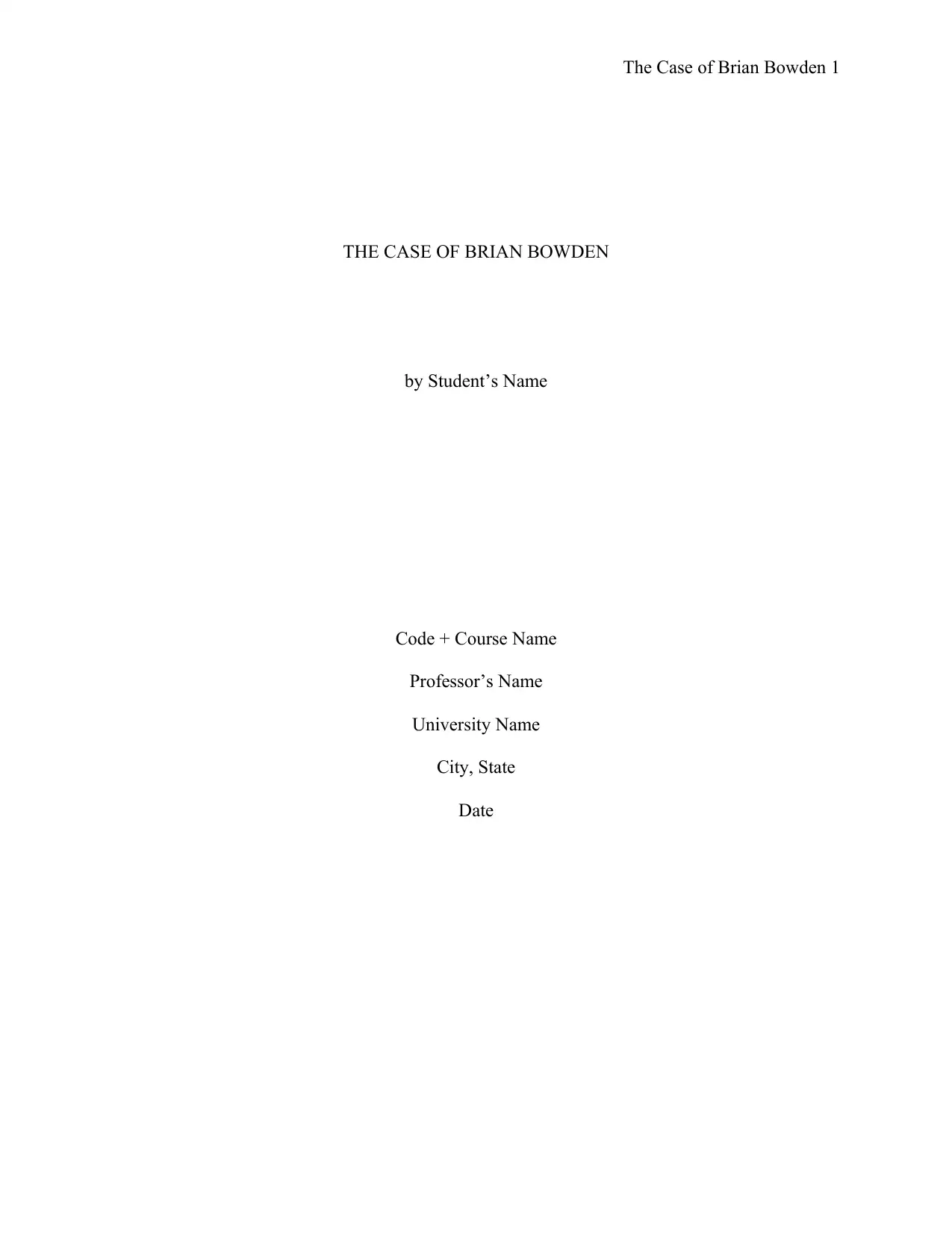
The Case of Brian Bowden 1
THE CASE OF BRIAN BOWDEN
by Student’s Name
Code + Course Name
Professor’s Name
University Name
City, State
Date
THE CASE OF BRIAN BOWDEN
by Student’s Name
Code + Course Name
Professor’s Name
University Name
City, State
Date
Paraphrase This Document
Need a fresh take? Get an instant paraphrase of this document with our AI Paraphraser
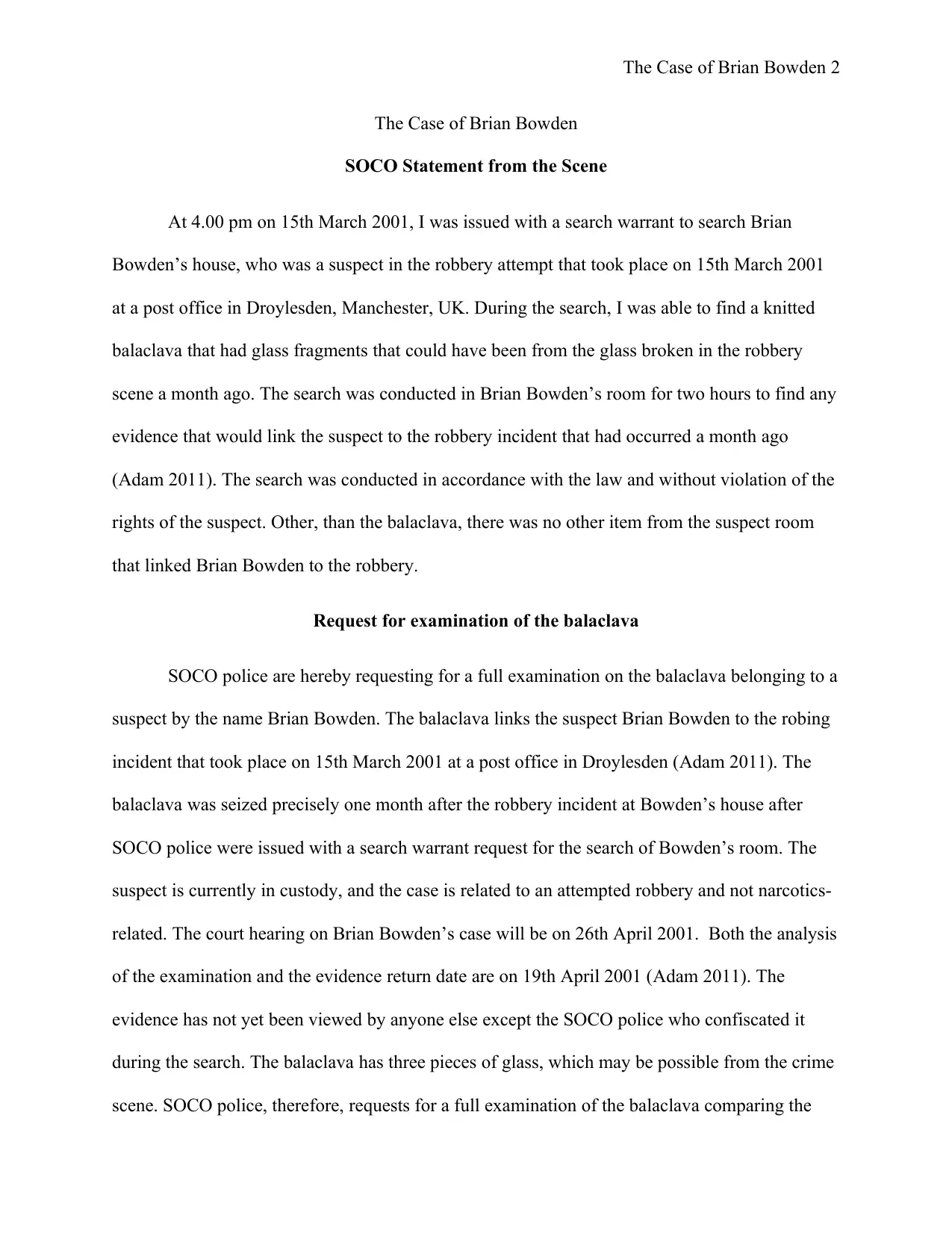
The Case of Brian Bowden 2
The Case of Brian Bowden
SOCO Statement from the Scene
At 4.00 pm on 15th March 2001, I was issued with a search warrant to search Brian
Bowden’s house, who was a suspect in the robbery attempt that took place on 15th March 2001
at a post office in Droylesden, Manchester, UK. During the search, I was able to find a knitted
balaclava that had glass fragments that could have been from the glass broken in the robbery
scene a month ago. The search was conducted in Brian Bowden’s room for two hours to find any
evidence that would link the suspect to the robbery incident that had occurred a month ago
(Adam 2011). The search was conducted in accordance with the law and without violation of the
rights of the suspect. Other, than the balaclava, there was no other item from the suspect room
that linked Brian Bowden to the robbery.
Request for examination of the balaclava
SOCO police are hereby requesting for a full examination on the balaclava belonging to a
suspect by the name Brian Bowden. The balaclava links the suspect Brian Bowden to the robing
incident that took place on 15th March 2001 at a post office in Droylesden (Adam 2011). The
balaclava was seized precisely one month after the robbery incident at Bowden’s house after
SOCO police were issued with a search warrant request for the search of Bowden’s room. The
suspect is currently in custody, and the case is related to an attempted robbery and not narcotics-
related. The court hearing on Brian Bowden’s case will be on 26th April 2001. Both the analysis
of the examination and the evidence return date are on 19th April 2001 (Adam 2011). The
evidence has not yet been viewed by anyone else except the SOCO police who confiscated it
during the search. The balaclava has three pieces of glass, which may be possible from the crime
scene. SOCO police, therefore, requests for a full examination of the balaclava comparing the
The Case of Brian Bowden
SOCO Statement from the Scene
At 4.00 pm on 15th March 2001, I was issued with a search warrant to search Brian
Bowden’s house, who was a suspect in the robbery attempt that took place on 15th March 2001
at a post office in Droylesden, Manchester, UK. During the search, I was able to find a knitted
balaclava that had glass fragments that could have been from the glass broken in the robbery
scene a month ago. The search was conducted in Brian Bowden’s room for two hours to find any
evidence that would link the suspect to the robbery incident that had occurred a month ago
(Adam 2011). The search was conducted in accordance with the law and without violation of the
rights of the suspect. Other, than the balaclava, there was no other item from the suspect room
that linked Brian Bowden to the robbery.
Request for examination of the balaclava
SOCO police are hereby requesting for a full examination on the balaclava belonging to a
suspect by the name Brian Bowden. The balaclava links the suspect Brian Bowden to the robing
incident that took place on 15th March 2001 at a post office in Droylesden (Adam 2011). The
balaclava was seized precisely one month after the robbery incident at Bowden’s house after
SOCO police were issued with a search warrant request for the search of Bowden’s room. The
suspect is currently in custody, and the case is related to an attempted robbery and not narcotics-
related. The court hearing on Brian Bowden’s case will be on 26th April 2001. Both the analysis
of the examination and the evidence return date are on 19th April 2001 (Adam 2011). The
evidence has not yet been viewed by anyone else except the SOCO police who confiscated it
during the search. The balaclava has three pieces of glass, which may be possible from the crime
scene. SOCO police, therefore, requests for a full examination of the balaclava comparing the
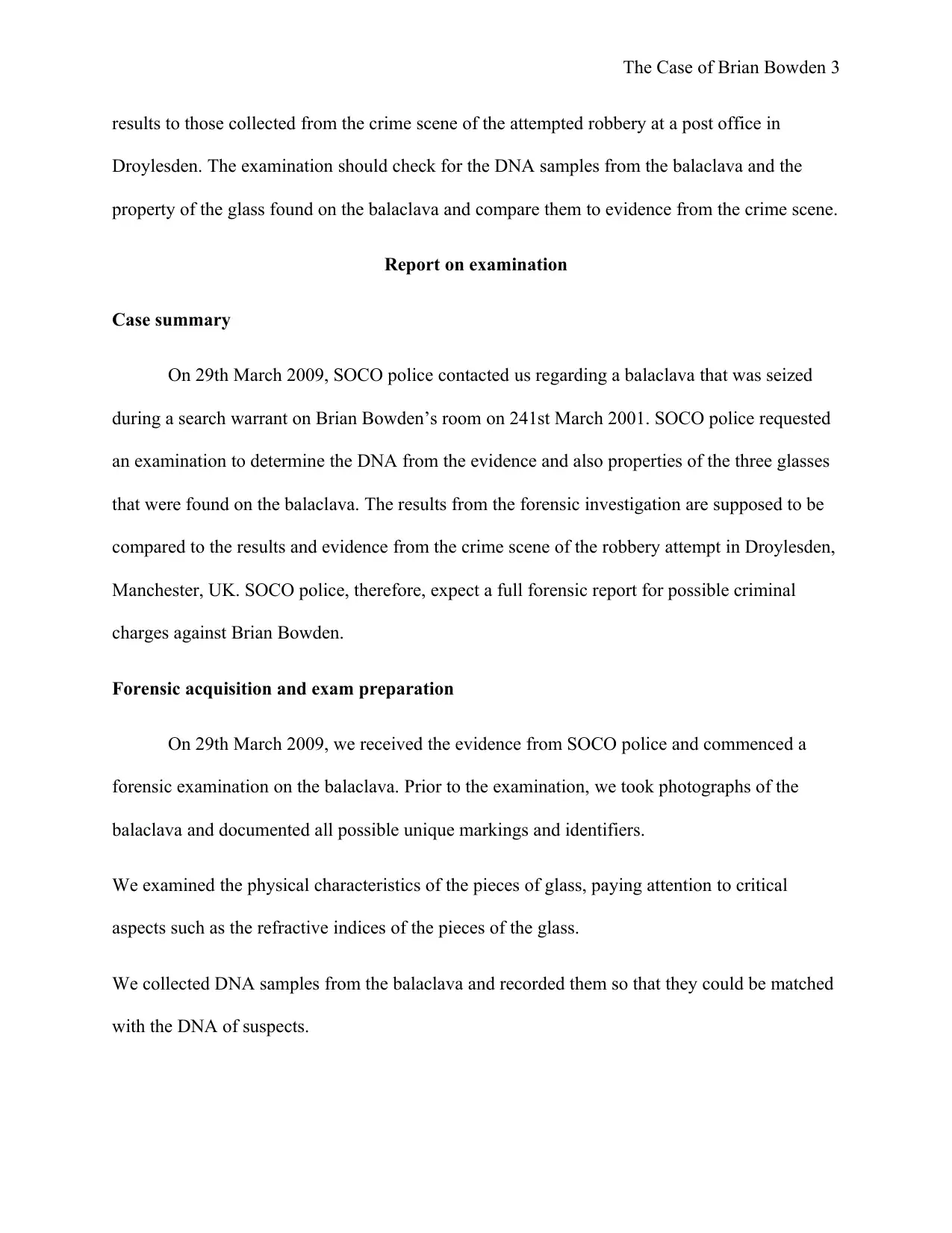
The Case of Brian Bowden 3
results to those collected from the crime scene of the attempted robbery at a post office in
Droylesden. The examination should check for the DNA samples from the balaclava and the
property of the glass found on the balaclava and compare them to evidence from the crime scene.
Report on examination
Case summary
On 29th March 2009, SOCO police contacted us regarding a balaclava that was seized
during a search warrant on Brian Bowden’s room on 241st March 2001. SOCO police requested
an examination to determine the DNA from the evidence and also properties of the three glasses
that were found on the balaclava. The results from the forensic investigation are supposed to be
compared to the results and evidence from the crime scene of the robbery attempt in Droylesden,
Manchester, UK. SOCO police, therefore, expect a full forensic report for possible criminal
charges against Brian Bowden.
Forensic acquisition and exam preparation
On 29th March 2009, we received the evidence from SOCO police and commenced a
forensic examination on the balaclava. Prior to the examination, we took photographs of the
balaclava and documented all possible unique markings and identifiers.
We examined the physical characteristics of the pieces of glass, paying attention to critical
aspects such as the refractive indices of the pieces of the glass.
We collected DNA samples from the balaclava and recorded them so that they could be matched
with the DNA of suspects.
results to those collected from the crime scene of the attempted robbery at a post office in
Droylesden. The examination should check for the DNA samples from the balaclava and the
property of the glass found on the balaclava and compare them to evidence from the crime scene.
Report on examination
Case summary
On 29th March 2009, SOCO police contacted us regarding a balaclava that was seized
during a search warrant on Brian Bowden’s room on 241st March 2001. SOCO police requested
an examination to determine the DNA from the evidence and also properties of the three glasses
that were found on the balaclava. The results from the forensic investigation are supposed to be
compared to the results and evidence from the crime scene of the robbery attempt in Droylesden,
Manchester, UK. SOCO police, therefore, expect a full forensic report for possible criminal
charges against Brian Bowden.
Forensic acquisition and exam preparation
On 29th March 2009, we received the evidence from SOCO police and commenced a
forensic examination on the balaclava. Prior to the examination, we took photographs of the
balaclava and documented all possible unique markings and identifiers.
We examined the physical characteristics of the pieces of glass, paying attention to critical
aspects such as the refractive indices of the pieces of the glass.
We collected DNA samples from the balaclava and recorded them so that they could be matched
with the DNA of suspects.
⊘ This is a preview!⊘
Do you want full access?
Subscribe today to unlock all pages.

Trusted by 1+ million students worldwide
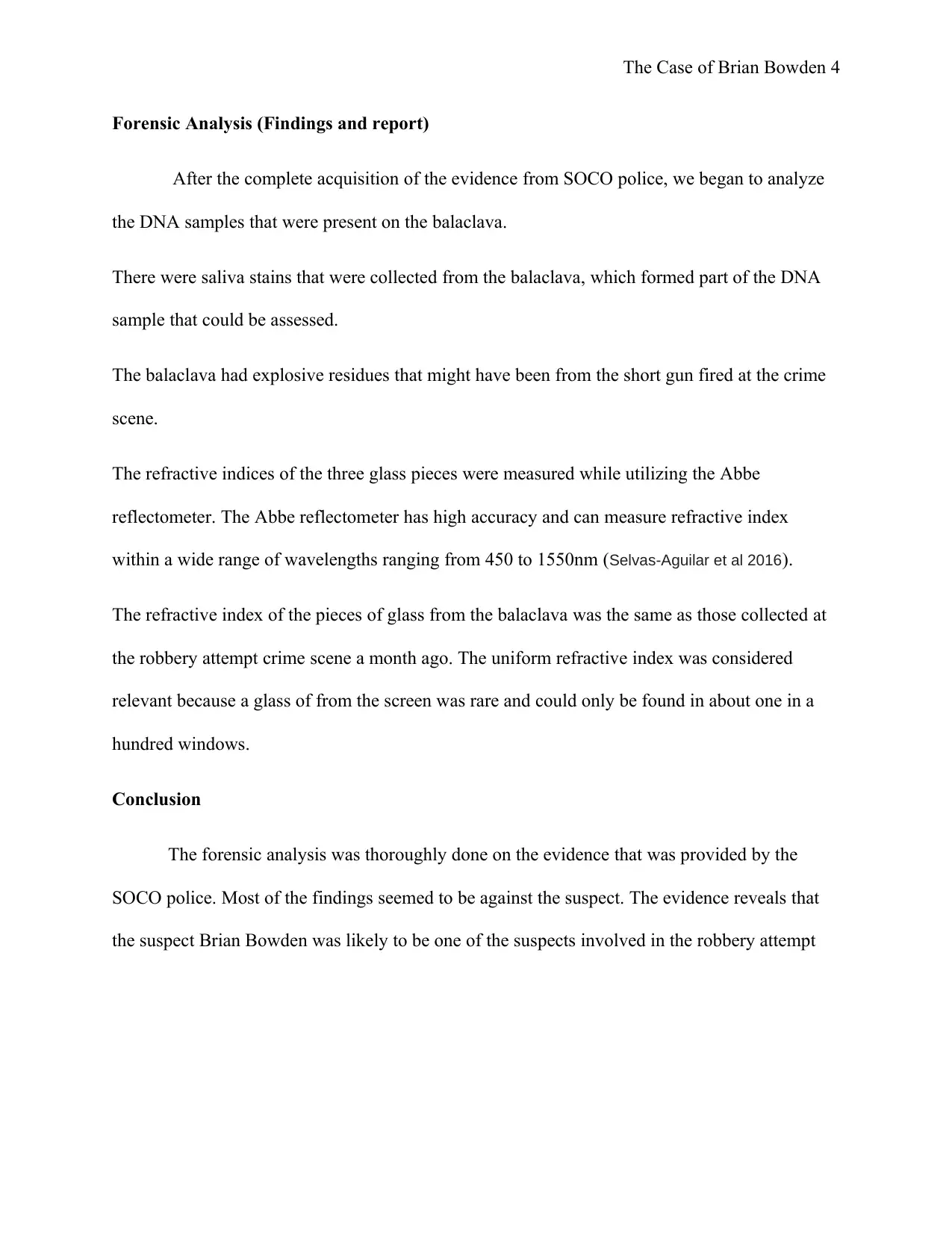
The Case of Brian Bowden 4
Forensic Analysis (Findings and report)
After the complete acquisition of the evidence from SOCO police, we began to analyze
the DNA samples that were present on the balaclava.
There were saliva stains that were collected from the balaclava, which formed part of the DNA
sample that could be assessed.
The balaclava had explosive residues that might have been from the short gun fired at the crime
scene.
The refractive indices of the three glass pieces were measured while utilizing the Abbe
reflectometer. The Abbe reflectometer has high accuracy and can measure refractive index
within a wide range of wavelengths ranging from 450 to 1550nm (Selvas-Aguilar et al 2016).
The refractive index of the pieces of glass from the balaclava was the same as those collected at
the robbery attempt crime scene a month ago. The uniform refractive index was considered
relevant because a glass of from the screen was rare and could only be found in about one in a
hundred windows.
Conclusion
The forensic analysis was thoroughly done on the evidence that was provided by the
SOCO police. Most of the findings seemed to be against the suspect. The evidence reveals that
the suspect Brian Bowden was likely to be one of the suspects involved in the robbery attempt
Forensic Analysis (Findings and report)
After the complete acquisition of the evidence from SOCO police, we began to analyze
the DNA samples that were present on the balaclava.
There were saliva stains that were collected from the balaclava, which formed part of the DNA
sample that could be assessed.
The balaclava had explosive residues that might have been from the short gun fired at the crime
scene.
The refractive indices of the three glass pieces were measured while utilizing the Abbe
reflectometer. The Abbe reflectometer has high accuracy and can measure refractive index
within a wide range of wavelengths ranging from 450 to 1550nm (Selvas-Aguilar et al 2016).
The refractive index of the pieces of glass from the balaclava was the same as those collected at
the robbery attempt crime scene a month ago. The uniform refractive index was considered
relevant because a glass of from the screen was rare and could only be found in about one in a
hundred windows.
Conclusion
The forensic analysis was thoroughly done on the evidence that was provided by the
SOCO police. Most of the findings seemed to be against the suspect. The evidence reveals that
the suspect Brian Bowden was likely to be one of the suspects involved in the robbery attempt
Paraphrase This Document
Need a fresh take? Get an instant paraphrase of this document with our AI Paraphraser
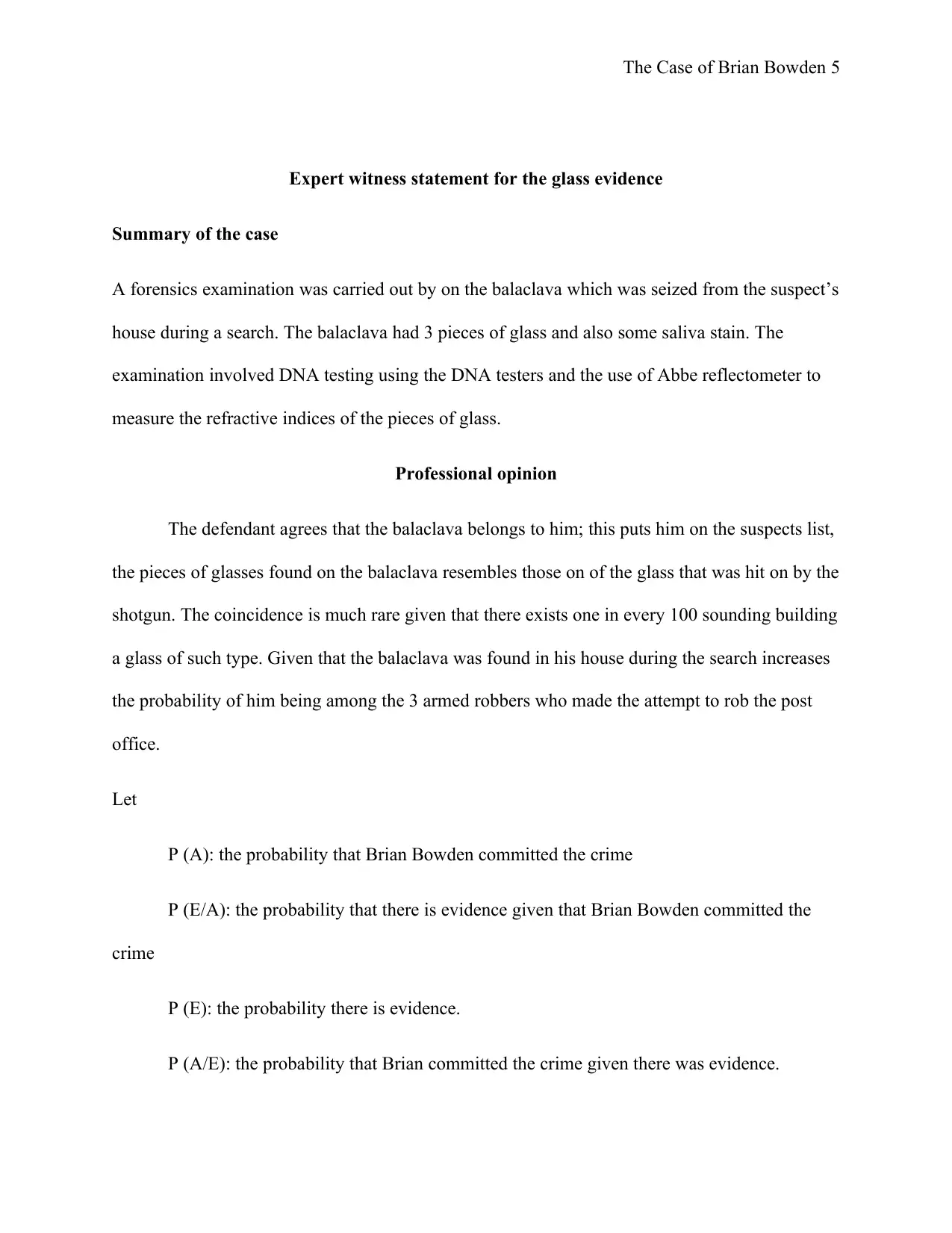
The Case of Brian Bowden 5
Expert witness statement for the glass evidence
Summary of the case
A forensics examination was carried out by on the balaclava which was seized from the suspect’s
house during a search. The balaclava had 3 pieces of glass and also some saliva stain. The
examination involved DNA testing using the DNA testers and the use of Abbe reflectometer to
measure the refractive indices of the pieces of glass.
Professional opinion
The defendant agrees that the balaclava belongs to him; this puts him on the suspects list,
the pieces of glasses found on the balaclava resembles those on of the glass that was hit on by the
shotgun. The coincidence is much rare given that there exists one in every 100 sounding building
a glass of such type. Given that the balaclava was found in his house during the search increases
the probability of him being among the 3 armed robbers who made the attempt to rob the post
office.
Let
P (A): the probability that Brian Bowden committed the crime
P (E/A): the probability that there is evidence given that Brian Bowden committed the
crime
P (E): the probability there is evidence.
P (A/E): the probability that Brian committed the crime given there was evidence.
Expert witness statement for the glass evidence
Summary of the case
A forensics examination was carried out by on the balaclava which was seized from the suspect’s
house during a search. The balaclava had 3 pieces of glass and also some saliva stain. The
examination involved DNA testing using the DNA testers and the use of Abbe reflectometer to
measure the refractive indices of the pieces of glass.
Professional opinion
The defendant agrees that the balaclava belongs to him; this puts him on the suspects list,
the pieces of glasses found on the balaclava resembles those on of the glass that was hit on by the
shotgun. The coincidence is much rare given that there exists one in every 100 sounding building
a glass of such type. Given that the balaclava was found in his house during the search increases
the probability of him being among the 3 armed robbers who made the attempt to rob the post
office.
Let
P (A): the probability that Brian Bowden committed the crime
P (E/A): the probability that there is evidence given that Brian Bowden committed the
crime
P (E): the probability there is evidence.
P (A/E): the probability that Brian committed the crime given there was evidence.
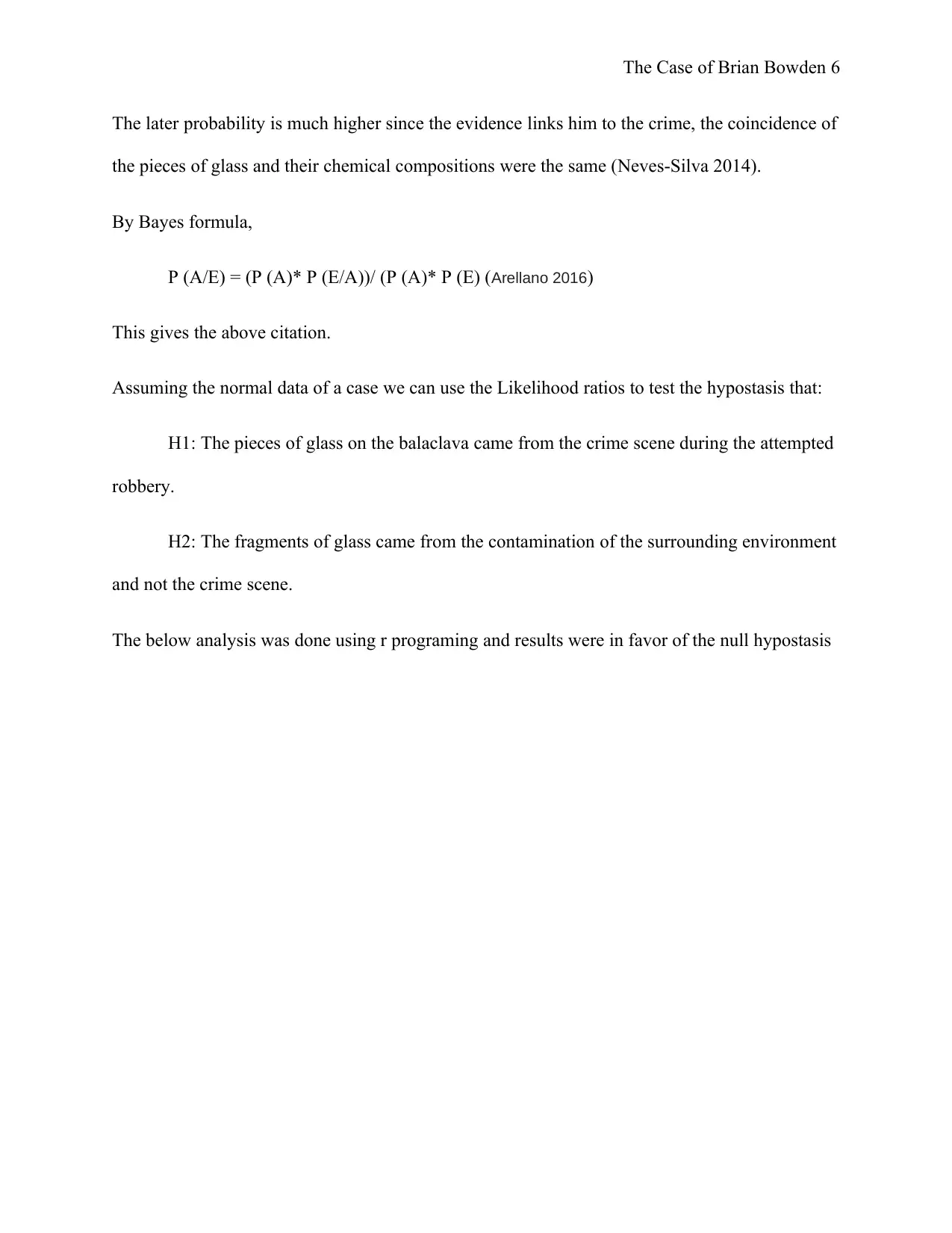
The Case of Brian Bowden 6
The later probability is much higher since the evidence links him to the crime, the coincidence of
the pieces of glass and their chemical compositions were the same (Neves-Silva 2014).
By Bayes formula,
P (A/E) = (P (A)* P (E/A))/ (P (A)* P (E) (Arellano 2016)
This gives the above citation.
Assuming the normal data of a case we can use the Likelihood ratios to test the hypostasis that:
H1: The pieces of glass on the balaclava came from the crime scene during the attempted
robbery.
H2: The fragments of glass came from the contamination of the surrounding environment
and not the crime scene.
The below analysis was done using r programing and results were in favor of the null hypostasis
The later probability is much higher since the evidence links him to the crime, the coincidence of
the pieces of glass and their chemical compositions were the same (Neves-Silva 2014).
By Bayes formula,
P (A/E) = (P (A)* P (E/A))/ (P (A)* P (E) (Arellano 2016)
This gives the above citation.
Assuming the normal data of a case we can use the Likelihood ratios to test the hypostasis that:
H1: The pieces of glass on the balaclava came from the crime scene during the attempted
robbery.
H2: The fragments of glass came from the contamination of the surrounding environment
and not the crime scene.
The below analysis was done using r programing and results were in favor of the null hypostasis
⊘ This is a preview!⊘
Do you want full access?
Subscribe today to unlock all pages.

Trusted by 1+ million students worldwide
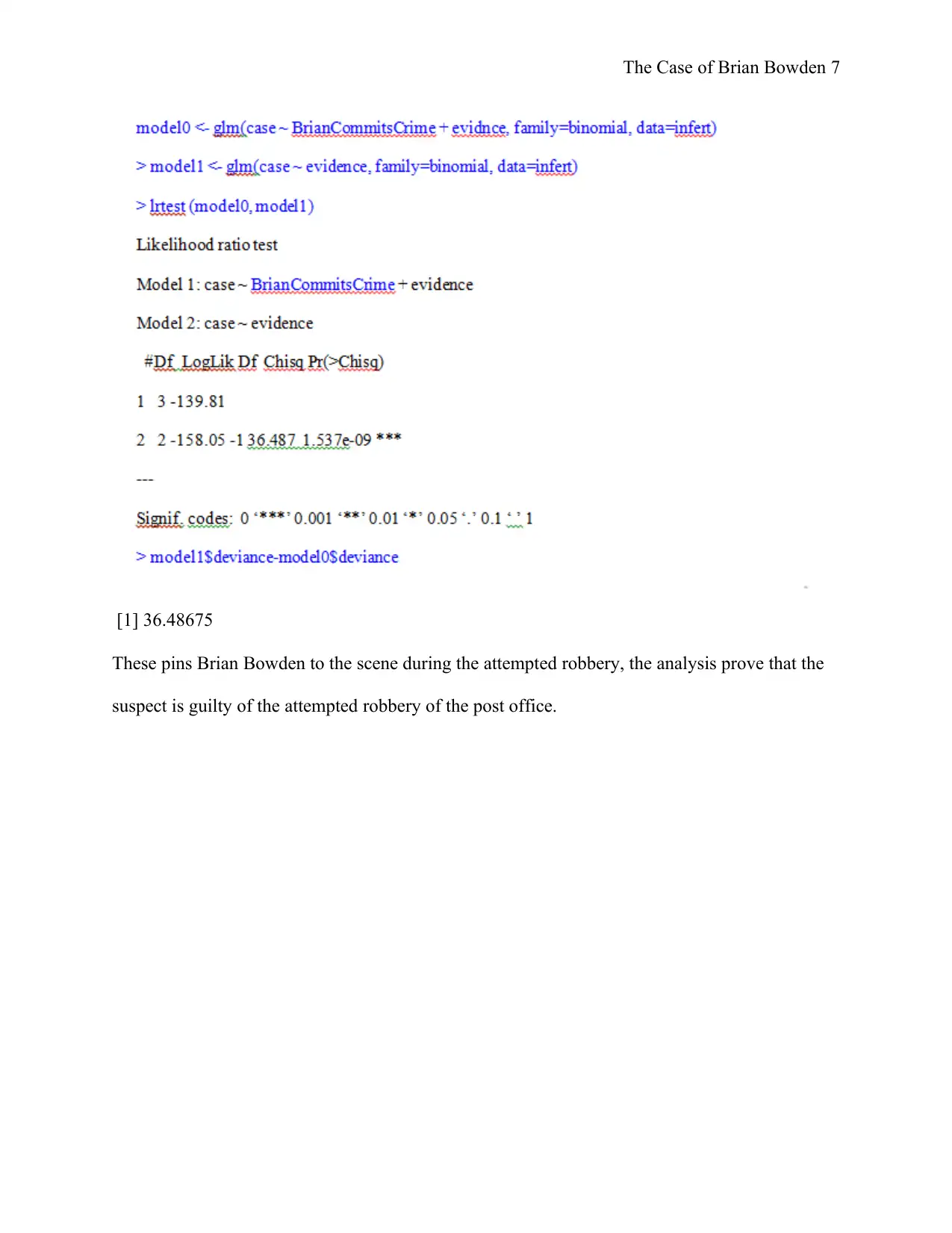
The Case of Brian Bowden 7
[1] 36.48675
These pins Brian Bowden to the scene during the attempted robbery, the analysis prove that the
suspect is guilty of the attempted robbery of the post office.
[1] 36.48675
These pins Brian Bowden to the scene during the attempted robbery, the analysis prove that the
suspect is guilty of the attempted robbery of the post office.
Paraphrase This Document
Need a fresh take? Get an instant paraphrase of this document with our AI Paraphraser
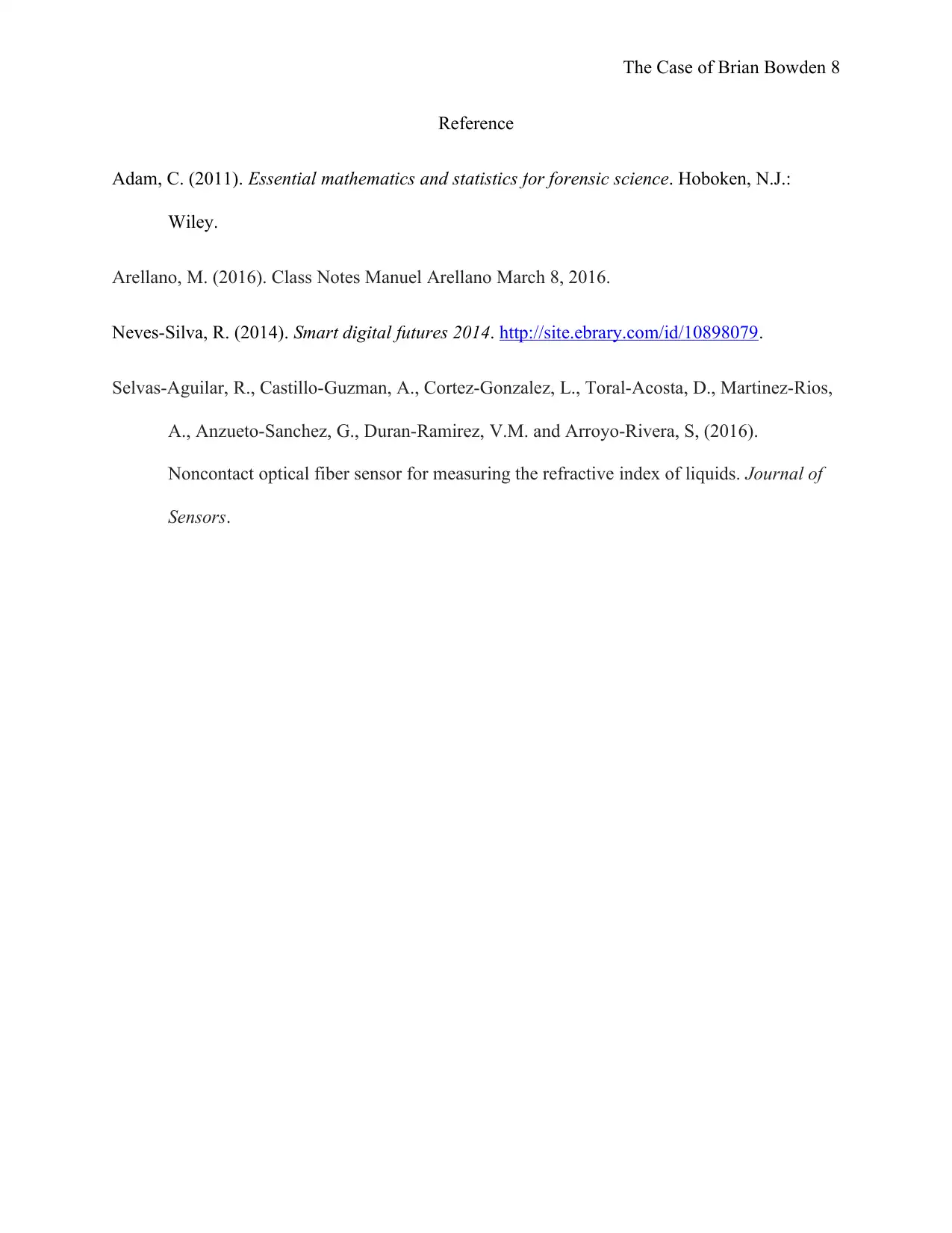
The Case of Brian Bowden 8
Reference
Adam, C. (2011). Essential mathematics and statistics for forensic science. Hoboken, N.J.:
Wiley.
Arellano, M. (2016). Class Notes Manuel Arellano March 8, 2016.
Neves-Silva, R. (2014). Smart digital futures 2014. http://site.ebrary.com/id/10898079.
Selvas-Aguilar, R., Castillo-Guzman, A., Cortez-Gonzalez, L., Toral-Acosta, D., Martinez-Rios,
A., Anzueto-Sanchez, G., Duran-Ramirez, V.M. and Arroyo-Rivera, S, (2016).
Noncontact optical fiber sensor for measuring the refractive index of liquids. Journal of
Sensors.
Reference
Adam, C. (2011). Essential mathematics and statistics for forensic science. Hoboken, N.J.:
Wiley.
Arellano, M. (2016). Class Notes Manuel Arellano March 8, 2016.
Neves-Silva, R. (2014). Smart digital futures 2014. http://site.ebrary.com/id/10898079.
Selvas-Aguilar, R., Castillo-Guzman, A., Cortez-Gonzalez, L., Toral-Acosta, D., Martinez-Rios,
A., Anzueto-Sanchez, G., Duran-Ramirez, V.M. and Arroyo-Rivera, S, (2016).
Noncontact optical fiber sensor for measuring the refractive index of liquids. Journal of
Sensors.
1 out of 8
Your All-in-One AI-Powered Toolkit for Academic Success.
+13062052269
info@desklib.com
Available 24*7 on WhatsApp / Email
![[object Object]](/_next/static/media/star-bottom.7253800d.svg)
Unlock your academic potential
Copyright © 2020–2025 A2Z Services. All Rights Reserved. Developed and managed by ZUCOL.